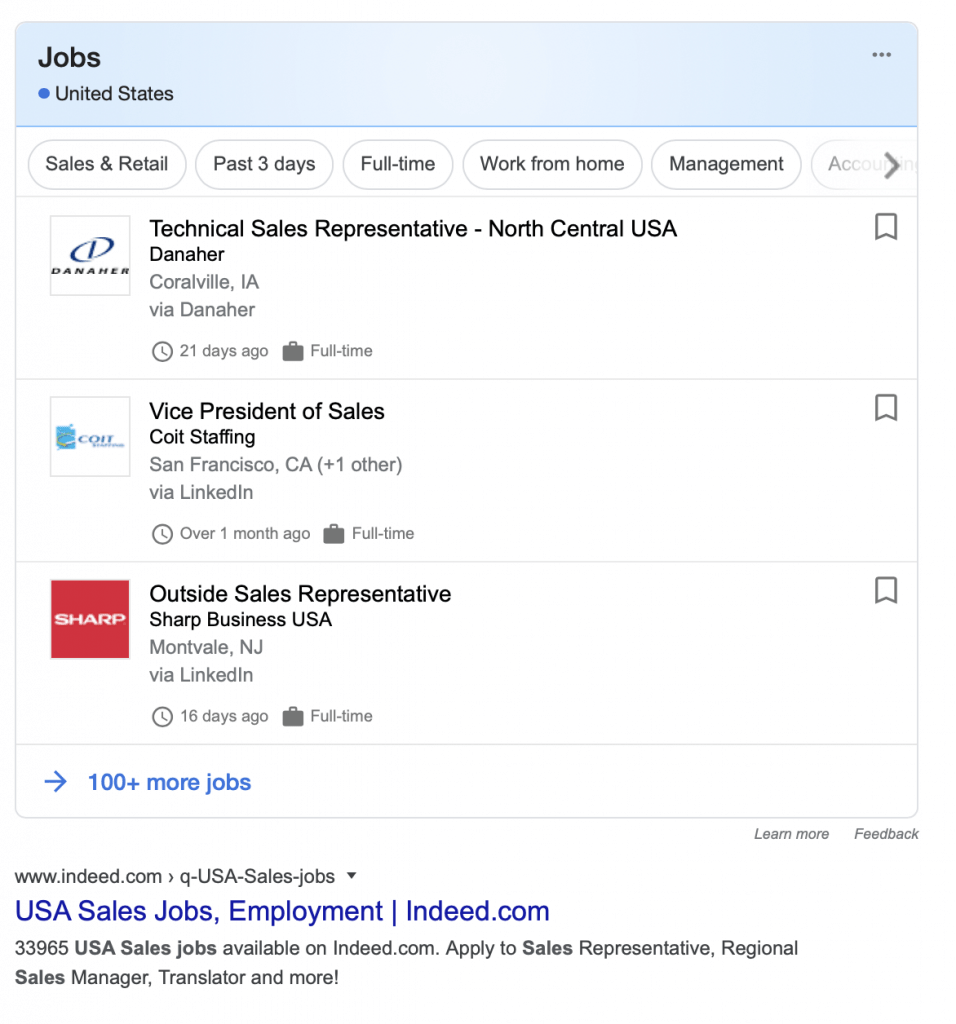Job boards have long been the online go-to for job seekers.
Indeed, arguably the number one job search platform in the world, has successfully established itself as a one-stop-shop for job seekers. They’re likely to show up first in organic search results for basically any job search. With over 250 million unique visitors on their site each month, they are undoubtedly the market leader.
As we know, though, Google has been steadily introducing features in its search engine results pages (that extend beyond “traditional” organic search results) for years. Think: Related Questions or Google My Business.
In 2017, this became worrisome for Indeed. Google launched a new feature — Google for Jobs (GFJ) — in its SERPs and began a push to revolutionize the online job search process.
Virtually overnight, platforms like Indeed and CareerBuilder lost a significant amount of organic traffic. Google took over the top spot in search, collating job posts across (almost) all job boards into the GFJ widget that syncs with users’ search intent.
Note, “almost” all job boards. Indeed does not post its jobs in GFJ. And because Indeed doesn’t integrate with GFJ, their results are no longer at the top of users’ browsers. They instead appear beneath the GFJ interface.
This is a missed opportunity for Indeed. If Indeed wisens up to this enormous opportunity, Google for Jobs could be in trouble.
Why?
Let’s look a bit deeper at how this battle between Google for Jobs vs Indeed could unfold and why Indeed needs to get onto Google for Jobs.
Google for Jobs: An (Almost) Consolidated Experience
While job boards are currently the go-to for many job seekers, there are key issues that prevent the experience from satisfying candidates. This means that many applications are abandoned, resulting in a lower ROI for employers.
These issues include:
- Faulty and/or hard-to-use search functions
- Expired and/or duplicate listings
- Redundant and/or confusing application processes
- Frustrating, multi-step process to access job info
- Difficulty and/or inability to apply directly on employer sites
Google took a shot at remedying these issues and intended for GFJ to create a more holistic, candidate-centered experience. Given that 75% of job seekers start their job searches on the platform, it made a lot of sense.
GFJ was to be a platform that would consolidate jobs from job boards, social media, and employer websites. At the same time, it would also create a seamless application process for job seekers.
Whether or not Google has fulfilled its mission to serve job seekers and posters the way it set out to is certainly in question — at least thus far.
The candidate experience is poor, requiring more than 2.5 clicks before getting to an employer’s website. And for employers, figuring out how to optimize their job postings is incredibly difficult.
Indeed is in a position to strike and capture even more of the online jobs market while Google seeks to clean up GFJ.
Why Indeed Needs to Be on Google for Jobs
Remember: Indeed doesn’t include its job postings on GFJ. This means that in order for job seekers to get to Indeed’s listings from a Google search, they must scroll past the GFJ widget to get to the organic results.

This simple fact has already resulted in Indeed losing a substantial portion of the traffic that they used to receive from Google.
As the number one job search site on the Internet, this only hurts Indeed. Especially given the fact that they could dominate both GFJ and organic search results if they started optimizing their posts on GFJ.
The only thing that’s really kept GFJ from overtaking Indeed is the complex structured schema that is required before getting listings on its platform.
Google lacks automated posting and optimization capabilities that would make it much easier for employers and recruiters to get their jobs on GFJ.
It’s also this schema & lack of easy use that’s kept Indeed from getting on GFJ.
Hear it right from the source.
Jobiak’s CEO Venkat Janapareddy delves into this topic on the Chad and Cheese podcast. Check it out here.
A New Technology
The good news for Indeed in this the Google for Jobs vs Indeed battle is that optimizing job posts no longer needs to be such a challenge. A newly available technology tackles Google’s schema requirements. It also automatically generates relevant keywords & optimizations to make listings candidate-focused & friendly.
If Indeed began using this technology, it would allow them to effectively and efficiently post optimized listings directly to GFJ.
This would help Indeed maintain its market-dominance and would also effectively put GFJ, well, out of a job.
Such a partnership would effectively push almost all employers, job posters, and job seekers to the Indeed platform. Indeed’s postings would appear at the top of almost all search results in the world.
Much like in organic search, other job boards and company websites would be pushed down beneath Indeed in GFJ rankings.
How complex can Google schema be? Learn that and more in our Ultimate Guide for Google for Jobs.
The Benefits for Indeed
Besides completely dominating the online recruiting space and rendering a major competitor redundant, this partnership would introduce substantial monetary gains for Indeed.
According to our calculations, Indeed could increase its non-branded organic monthly traffic from Google by 35% if it structured its jobs to align with GFJ.
This could translate to an additional $227.7 million (low-end estimate) in annual revenue for Indeed. From GFJ alone! That means that this is a billion dollar idea. Literally.
Moreover, Indeed could recapture the organic traffic they lost from the GFJ launch, and even generate supplemental revenue from sponsored posting opportunities.
Let’s put it simply. When Indeed integrates with a platform that offers an automated, reliable, and cost-effective way to get all job postings optimized everywhere (including in GFJ and organic search results), GFJ could be in real trouble.
Even though almost 75% of job seekers start their searches on Google, this would make Google’s own SERP tool effectively useless. Either way — in organic search or in GFJ — candidates would find themselves searching for jobs on Indeed.





